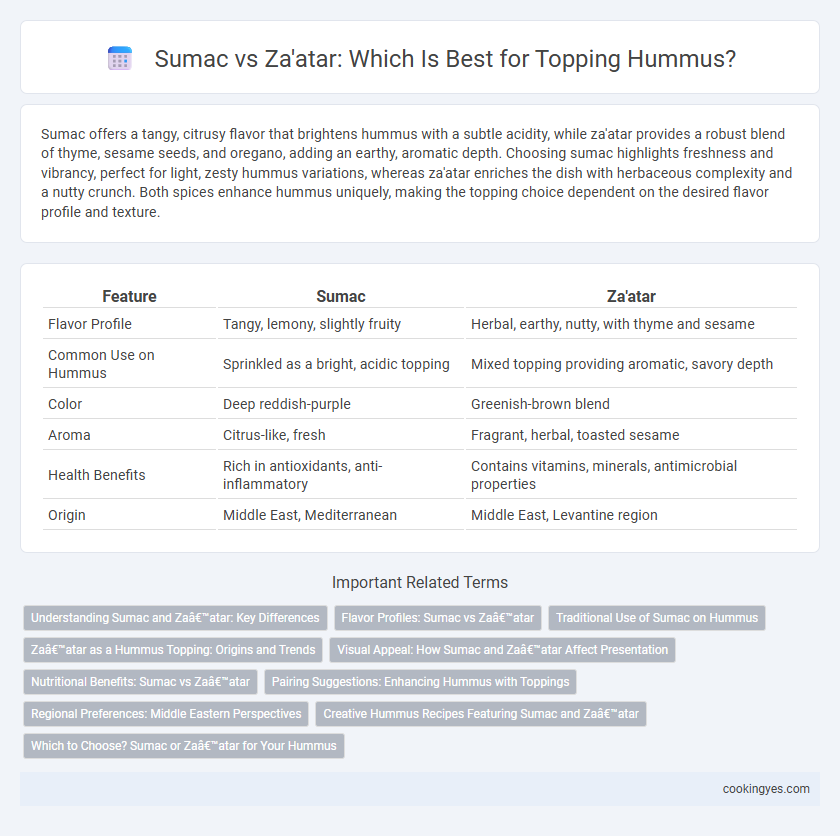Sumac offers a tangy, citrusy flavor that brightens hummus with a subtle acidity, while za'atar provides a robust blend of thyme, sesame seeds, and oregano, adding an earthy, aromatic depth. Choosing sumac highlights freshness and vibrancy, perfect for light, zesty hummus variations, whereas za'atar enriches the dish with herbaceous complexity and a nutty crunch. Both spices enhance hummus uniquely, making the topping choice dependent on the desired flavor profile and texture.
Table of Comparison
| Feature | Sumac | Za'atar |
|---|---|---|
| Flavor Profile | Tangy, lemony, slightly fruity | Herbal, earthy, nutty, with thyme and sesame |
| Common Use on Hummus | Sprinkled as a bright, acidic topping | Mixed topping providing aromatic, savory depth |
| Color | Deep reddish-purple | Greenish-brown blend |
| Aroma | Citrus-like, fresh | Fragrant, herbal, toasted sesame |
| Health Benefits | Rich in antioxidants, anti-inflammatory | Contains vitamins, minerals, antimicrobial properties |
| Origin | Middle East, Mediterranean | Middle East, Levantine region |
Understanding Sumac and Za’atar: Key Differences
Sumac is a tangy, lemony spice derived from dried and ground sumac berries, adding a bright, citrusy flavor to hummus toppings, while za'atar is a Middle Eastern blend of dried thyme, oregano, sesame seeds, and sumac, offering a more complex, herbal and nutty profile. Sumac enhances hummus with its vibrant acidity and subtle tartness, whereas za'atar provides layered earthiness and a crunchy texture from sesame seeds. Choosing between sumac and za'atar depends on whether a straightforward citrus zing or a multifaceted herbaceous seasoning is desired for hummus.
Flavor Profiles: Sumac vs Za’atar
Sumac offers a tangy, lemony flavor that brightens the creamy texture of hummus, enhancing its earthy chickpea base. Za'atar combines thyme, sesame seeds, and sumac, delivering a complex, herbaceous, and slightly nutty taste that adds depth and aromatic richness. Choosing between sumac and za'atar depends on whether a simple citrusy zest or a layered, savory herb blend is preferred to complement the hummus.
Traditional Use of Sumac on Hummus
Sumac, a tangy and lemony spice, is traditionally sprinkled on hummus to enhance its flavor with a vibrant and slightly acidic note. Unlike za'atar, which combines herbs, sesame seeds, and sumac, pure sumac offers a more straightforward, bright taste that complements the creamy texture of hummus without overpowering it. Middle Eastern recipes frequently use sumac as a classic topping, highlighting its role in preserving the authentic taste and aroma of hummus.
Za’atar as a Hummus Topping: Origins and Trends
Za'atar, a Middle Eastern spice blend consisting of dried thyme, sesame seeds, sumac, and salt, has gained popularity as a vibrant topping for hummus due to its aromatic and tangy flavor profile. Its origins trace back to Levantine cuisine, where it enhances hummus by adding a complex, herbal depth that contrasts with the creamy texture. Current culinary trends emphasize Za'atar's versatility and health benefits, making it a favored choice over sumac alone for elevating traditional hummus recipes.
Visual Appeal: How Sumac and Za’atar Affect Presentation
Sumac enhances hummus presentation with its vibrant red hue, creating an eye-catching contrast against the creamy beige base, while za'atar adds a speckled green-brown texture that introduces visual complexity. The fine powder of sumac distributes evenly, resulting in a smooth, colorful garnish, whereas za'atar's mix of herbs and sesame seeds provides a rustic, textured appearance. Both toppings elevate hummus visually, but sumac offers a cleaner, more uniform look, and za'atar brings an organic, earthy aesthetic.
Nutritional Benefits: Sumac vs Za’atar
Sumac and za'atar both offer unique nutritional benefits when used as hummus toppings, enriching the dish with antioxidants and essential minerals. Sumac is rich in vitamin C and has strong anti-inflammatory properties, supporting immune health. Za'atar combines sumac, sesame seeds, and herbs like thyme, adding fiber, calcium, and iron that promote digestion and bone health.
Pairing Suggestions: Enhancing Hummus with Toppings
Sumac's tangy, lemony flavor brightens hummus, complementing its creamy texture and adding a vibrant, zesty twist ideal for fresh vegetable pairings. Za'atar, a robust blend of thyme, sesame, and sumac, infuses hummus with earthy, herbal notes that deepen the flavor profile, perfect for drizzling olive oil over warm pita bread or roasted veggies. Combining sumac and za'atar toppings creates a balanced medley of tartness and herbaceous warmth, elevating hummus as a versatile dip for diverse Mediterranean-inspired dishes.
Regional Preferences: Middle Eastern Perspectives
Sumac offers a tangy, lemony flavor prized in Levantine hummus, especially in Lebanon and Syria, where it enhances the dish's brightness. Za'atar, a blend of thyme, sesame seeds, and sumac, is favored in Palestinian and Jordanian kitchens for its earthy, herbal notes that complement the creamy texture of hummus. Regional preferences highlight Levantine reliance on pure sumac for a sharp contrast, while other Middle Eastern areas integrate za'atar for a complex, aromatic profile on hummus toppings.
Creative Hummus Recipes Featuring Sumac and Za’atar
Sumac and za'atar each bring distinctive flavors that elevate hummus, with sumac offering a tangy, lemony zest and za'atar providing a robust blend of thyme, sesame, and oregano. Creative hummus recipes often combine sumac for its vibrant acidity and za'atar for its earthy, herbal depth, creating a balanced topping that enhances the creamy texture and nutty flavor of chickpeas. Incorporating these spices into hummus toppings not only intensifies taste but also adds a colorful, aromatic garnish that appeals to both traditional and adventurous palates.
Which to Choose? Sumac or Za’atar for Your Hummus
Sumac offers a tangy, lemony flavor that brightens hummus with a subtle acidity, enhancing its creamy texture without overpowering the dish. Za'atar combines ground thyme, sesame seeds, and sumac to deliver an earthy, herbal, and slightly nutty taste that adds complexity and depth to hummus. Choosing between sumac and za'atar depends on whether you prefer a simple citrusy kick or a more robust herbaceous profile to complement your hummus.
Sumac vs Za’atar for Hummus Topping Infographic

 cookingyes.com
cookingyes.com